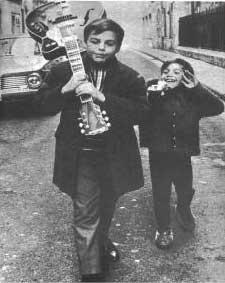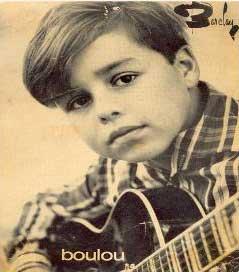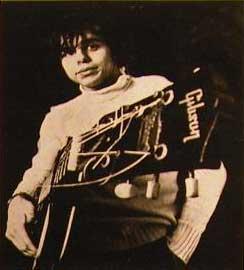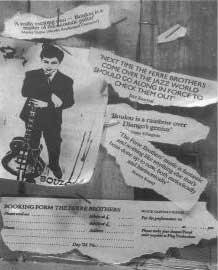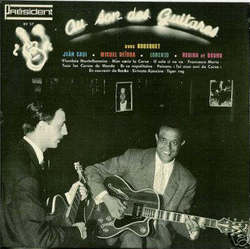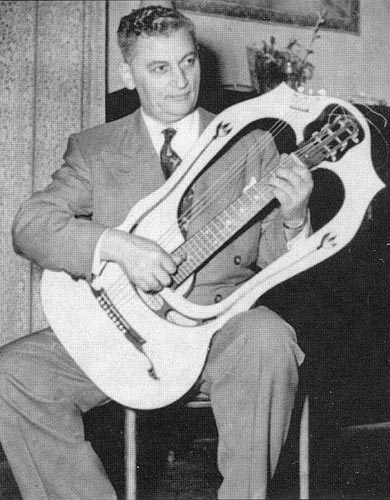These two MP3s are the only suriving recordings of Mario Maccaferri:
MP3: Bach
MP3: Granados
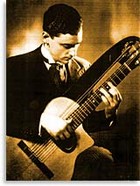
The plastic guitar
Like the plastic clothespin before it, however, the plastic
ukulele was merely a stepping stone to Maccaferri’s higher ambition of
making a plastic guitar. Let’s face it, ukes hardly represent a great
sonic challenge, but making a guitar out of Dow Styron? That’s
something else altogether!
The Maccaferri plastic guitar debuted in the Spring of 1953. The
introduction was extensively covered by The Music Trades in May of ’53,
which reported a press luncheon thrown by Dow Chemical for Mario
Maccaferri at the Waldorf-Astoria hotel in New York on April 29, 1953.
Described in glowing terms – lunch must have been great – Maccaferri
introduced two guitars and emphasized the resources and cost of
developing his new guitars. Indeed, Amos Ruddock of Dow’s plastic
merchandising department indicated that the project took two years of
testing various formulations of Styron and another Dow plastic called
Ethocel and that tooling up cost around $350,000.
The Music Trades quoted Maccaferri’s speech at length. While referring
to a painting of legendary violinmaker Antonio Stradivarius working at
his bench with a few simple tools, Maccaferri remarked, “A like
painting symbolizing such craftsmanship today would have to suggest the
following elements: 1. Some idea of the enormous industrial resources
and scientific know-how of America today; 2. Not one genius, but a
dozen of them; 3. The pile of money necessary to accomplish the task.”
After citing famous musicians and composers, particularly Paganini, who
played the guitar for their own personal enjoyment and wrote music for
it, Maccaferri continued, “I have always promised myself that one day I
would make a good guitar at a popular price. I had no idea that I would
end up by making a plastic guitar. But when I realized that plastic
would offer me the chance to make a perfect instrument with none of the
shortcomings known in the wooden guitar, it did not take long to decide
and satisfy my life’s ambition. So, I went to work.
“Often in my lifetime of playing guitar, I have had disappointments in
its performance. On many occasions I would find the instrument’s neck
warped or the fretting defective, or the body of the instrument
expanded or contracted, caused by humidity or dryness; thus making my
guitar simply unplayable. Anyone playing the guitar knows what I mean.
“Although today’s fine wooden guitars are the result of 300 years of
guitar making experience, I do not hesitate to say that our 1953
all-plastic guitar compares favorably with any wooden guitar made.
“This all-plastic guitar wasn’t an easy job, as you will understand. We
had a lot of engineering problems and it represents quite a costly
venture for us, but the Dow Chemical Company came up with suitable
materials and we overcame the other problems. To this instrument we
have applied all the improvements that guitar players have been seeking
in it for many years. It has beauty and it is easier to play – it
produces music in perfect pitch, and it has good tone and plenty of it.
And this all-plastic guitar is not subject to any of the shortcomings
mentioned earlier.”
Heavyweight support
While Arthur Godfrey was a great endorser of Maccaferri’s
Islander Ukulele, it might surprise you to learn that Maccaferri
brought his plastic guitar to the world bearing the endorsements of
none other than classical maestros Andres Segovia, his old friend from
the Twenties, and Rey De La Torre, and pop-jazz great Harry Volpe. De
La Torre and Volpe attended the luncheon and performed on Maccaferri
guitars, making the guitar “speak for itself,” after which Maccaferri
himself was prevailed upon to toss up a “lively Neopolitan melody with
skill and dexterity.”
G30 and G40
The two guitars Maccaferri introduced at the Waldorf were
described as “full, master size instruments,” “the flat-top, arched
bottom, cutaway model retailing at $29.95; and the DeLuxe Arched Top at
$39.95.” While the denomination is strange, it’s these which would
quickly be known as the G30 and G40, respectively. Both had similar,
Selmer-like shapes with the Maccaferri square cutaway, the former with
a flat top, the latter with an arched top. Pictured in the article are
Maccaferri and Volpe getting down with a pair of plastics, Maccaferri
on a G30, and Volpe holding a striking version of what looks like a G40
with an ivory (a.k.a. “maple”) fingerboard. These are quite remarkable
pieces of technology, each composed of more than 100 separate parts,
not all plastic, to be truthful.
Both had fancy headstocks with Maccaferri’s patented planetary tuning
machines. These were “banjo” style tuners with a 14:1 ratio, a patented
design using three interlocking gears. The G30 had a molded-in bridge
assembly to which the strings attached and a separate plastic saddle
glued in. The G40 had a glued-on archtop-style bridge and a fancy
trapeze tailpiece. Both had two f-holes. Curiously enough, wooden
struts were glued under the tops. The tops were ivory, the sides and
backs done up in a swirled reddish-brown rosewood color. Both were, by
the way, steel-stringed guitars, not nylon stringed instruments like
the Islander ukes. One point to note: early G30s had only the molded
bridge assembly. Some time later a plain metal trapeze tailpiece was
added. This did not serve as the anchor for the strings, but either as
some sort of added support for the bridge assembly or as merely
decoration.
The most curious design elements concerned the neck. The neck was
bolted on the guitar in an early version of a slightly cutaway heel.
The outside of the neck consisted of two pieces of plastic, the outer
back and the fingerboard. The fingerboard bore actual frets and white
position markers (which are actually part of the back and how the parts
are aligned). Inside there’s a metal sheath, referred to as an “armored
neck,” and at the core a piece of wood. This design was guaranteed
never to warp.
Already we’ve described a pretty interesting bit of guitar design, but
wait, there’s more! This neck was essentially a neck-through design.
The inner core ran all the way through the body to the endpin. There it
was notched and had a threaded bolt running perpendicular to it. This
bolt had a couple nuts above and below the neck core and was slotted.
By removing a metal plug from a hole on the top of the guitar down at
the bottom of the lower bout, you can use a screwdriver and basically
adjust neck tilt and therefore action by tightening or loosening this
bolt!
OK, we have a plastic guitar with a warp-proof neck, perfect
intonation, adjustable action and pretty natty faux-rosewood looks.
Let’s cut to the chase. How does it sound? Well, beauty is in the ear
of the beholder, but in my opinion pretty good, indeed. The tone is not
really like a typical wood sound. In some ways it’s sort of like an
acoustic variant of the Strat’s out-of-phase sound, kind of funky. In a
good one, the balance and sustain are quite remarkable. Of those I’ve
personally played, I’ve found the newer ones to have better sound, and
I prefer the tone of the flattop G30 to the more upscale archtop G40.
If I were a recording artist, I’d consider a G30 as an indispensable
part of my studio arsenal, and would never apologize for the tone.
More toys
With all the fuss over the introduction of Maccaferri’s plastic
guitars, they went over among guitarists, well, like a plastic guitar.
Guitar players, as you know, are a pretty conservative lot when it
comes to instruments, and the Maccaferris probably were never able to
shed the “toy” image. Some reports suggest that quite a few of these
guitars were sold, however, how many is unknown.
Despite the luke-warm reception of the plastic guitars, Maccaferri
forged ahead with his plastic instrument empire. In the Winter of 1953
the Islander Baritone Ukulele was added to the line, just in time for
the holiday season.
In a February 1954 ad in The Music Trades, the Maccaferri line included
the new Islander Baritone Ukulele ($12.95), the G30 ($35.95 with case)
and G40 ($45.95 with case) guitars, the U150 Islander Ukette ($1.00),
the C100 Chordmaster attachment, the U400 Islander Ukulele ($3.95), the
U600 Islander DeLuxe Ukulele and MU25 Midget Uke ($.25). Both Islander
Ukes came in a “Combination” package (UC500 for $4.95 and UC700 for
$6.95); just what that combination consisted of is unknown, but was
probably the Chordmaster and accessories, as before.
In an undated catalog supplied by Michael Lee Allen, probably from
around this time based on pricing, the Maccaferri uke line consisted of
the Islander uke ($4.50 alone, $5.70 with Chordmaster, books and
accessories), the T.V. Pal, a stripped down version of the Islander
($1.75), the Islander DeLuxe ($5.95), and the Islander Baritone
($12.95).
The Islander Guitar
Also introduced in February of 1954 was the No. G16
“Popular-Priced” Islander Guitar. This was basically a standard
acoustic flattop version of the fancier G30. This was 35″ long, 13″
wide and 4°” deep. It had a round soundhole and the same bridge
unit as the G30. The neck had the same design as its bigger brothers,
although it is unknown if the action was adjustable as on the f-hole
models.
The coolest thing about the G16 was the choice of finishes. It could be
had with mahogany grain body, ivory top and ebony fingerboard, with
mahogany grain boy and top with an ivory fingerboard, and with an ebony
grained body and top with ivory fingerboard. These had the typical
Maccaferri headstock with planetary tuners.
The classic Maccaferri G30, G40 and G16 plastic guitars were kept in
the line until the instrument business was ended in 1969, although
production was sporadic during these years. The Maccaferris’ typical
approach was to make a large batch of products and then inventory them
until more were needed. How many of these guitars were actually
produced over the years is impossible to tell, but there were quite a
few sold, although certainly not approaching the 9 million uke mark.
When the remaining assembled stock was liquidated in the early ’90s,
nearly 5,000 instruments were still available.
The Romancer
In June of 1957 Maccaferri introduced the Romancer Classic Style
Guitar, No. R20. This was advertised as a “standard-size” guitar, 35″
long, 13″ wide and 4°” deep. It featured Maccaferri’s patented
planetary tuners and fancy headstock. The body and neck had now become
a single molded unit, more like the ukuleles than the elaborate bolt-on
affair on the G30/G40/G16s. The copy alludes to “Wood-armoured neck and
body,” which we can presume to mean there was wood reinforcement inside
the neck and probably wooden struts. The neck and body were made of
“grained ebony” plastic, while the top and fingerboard were ivory,
silkscreened with decorations. The body had music staves looking like
ribbons and five different musical scenes of teens getting down. One
was a trio (a la Kingston), two guys solo, a little jazz combo with a
piano (a la Nat King Cole?), and a guy and gal duo. The position
markers on the fingerboard were little pictures. The Romancer came with
a rope strap, guitar method and pick, “very easy to play, and
luxuriously finished – the ideal guitar for any type of music – from
classical to popular, folksong, Calypso, Rock ‘n Roll, etc.”
ShowTime
Among the later plastics was the ShowTime classical guitar shown
here, a nylon-stringed axe with teen scenes which, based on the look of
the teens is probably circa 1960 vintage. This looks to be another
iteration of the Romancer. Although the headstock contains Maccaferri’s
trademark planetary tuners, this guitar has a molded neck attached to
the body similar to the Romancer. Instead of inlaid metal frets, this
has plastic frets molded into the fingerboard and painted silver.
Despite this unflattering description, again the tonal response is
quite good. Hey, it isn’t a Ramirez, but for what it is, a plastic
classical, it has a distinctive character.
Electrics
Among the many whimsical plastic Maccaferri designs of this era
was a brief early ’60s excursion into electric guitars with the small
Maestro electric tenor guitar. This guitar had four strings and a short
18*” scale, and contained its own battery powered amplifier. Strings
attached either to a trapeze tailpiece or onto the bridge, as the
player desired. The Maestro had one single-coil pickup at the lead
position. Tuners were the basic open-backed variety.
Sometime during this period Maccaferri also added various plastic horns
to his repertoire.
Introducing the Beatles…
The last notice of Maccaferri’s instruments occurred in the
July, 1964, The Music Trades, in which the new “Beatles” line was
discussed. The company was now identified as Mastro Industries, Inc.
Introduced in March of ’64, significantly at the Toy Show in New York,
the Beatles line marked a final burst of success for the Maccaferri
venture. Maccaferri had obtained the exclusive U.S. license to market
official instruments using The Beatles name.
Included were four Beatle guitar models made of “Beatle Red” and
“Beatle Orange” injection molded polystyrene plastic bodies. The ivory
tops included brown printed portraits of the Fab Four with
reproductions of their signatures. Two four-string tenor guitars were
offered, the Jr. Guitar and the Four Pop, and two small-bodied
six-strings, the Yeah Yeah and the Beatle-ist. Construction appears to
be similar to that of the ShowTime. Each came with instructions, song
book and a pick.
The Mastro Beatle line also included a set of Ringo Drums, plastic
bongo drums and a plastic banjo. There was also a miniature Pin-Up
guitar which was a 5″ replica of the real Beatle plastic guitar!
According to the article in The Music Trades, Mastro had already
shipped 500,000 of the Beatle guitars and was projecting two million by
the end of the year. Whether or not Maccaferri ever met that projection
is unknown, but Beatlemania, too, began to spread out and change
quickly as the fans grew older and the pace of the decade picked up.
1965 plastics
A good picture of the mature Maccaferri Mastro line can be seen
in the 1965 catalog. Top of the line were the G-40 archtop and G-30
flat top, followed by the Showtime No. 1020 (sans decoration) and
Romancer No. 1010. By this time both the Showtime and the Romancer had
an amazing neck design which featured a tension screw inside the body
at the heel accessible with a long screw driver. Tightening or
loosening the screw changed the neck tilt and therefore the action.
Also available were the G-16 Islander Guitar, the 35″ Mastro G-10
Guitar with armoured neck, and the 31″ Mastro G-5 Guitar.
In addition, there were two versions of the 30″ nylon-stringed Sonora
Guitars No. 727. The A-SH was in a marbled woodgrain color, while the
IC was in cream and black. Under these were the No. 500 TV Pal Guitar
in two colors (PIC) or woodgrain (A-SH). The No. 775 Western Guitar
featured singing cowboys, bucking broncos, boots and saddles on the
front.
Still in the line were a small Maestro electric six-string and tenor
guitars. The GTA-5 Electric Guitar was a 32″ woodgrain-colored
non-cutaway acoustic with a small humbucker attached near the bridge.
The wiring came out the treble side through a tube into a small housing
with a volume control and jack for a mini-plug. The CT GTA-5 Tenor
Cutaway Electric Guitar was basically a four-string version, with the
optional string attachment at the tailpiece or bridge. These guitars
had a new patent-pending design which featured a rigid metal beam which
ran through the guitar from the nut to the heel, detouring toward the
back once inside the body. Both were played through the matching TA-5
Mastro Amplifier, a small 5-watt portable transistor amp with a 6″
speaker, operating off two 9-volt batteries.
The recently introduced Beatle line was also available, of course.
Beatles guitars included the 30°” Beatle-Ist Guitar (No. 340), the
22″ Beatles Yeah-Yeah Guitar (No. 330), the 21″ Beatles Four Pop Guitar
(No. 320, four-string), and the 14°” Beatles Jr. Guitar (No. 300).
The 22″ Beatles Banjo (No. 350) was offered, as were the Beatles Ringo
Snare Drum (No. 380), the Beatles Beat Bongo (No. 360), the Beatles Big
Beat Bongo (No. 370), and the Mastro Beatles “Pin-Up” Guitar, miniature
guitars you could clip on your shirt. All had portraits and signatures
of the Fab Four on the front.
Two cutaway baritone ukes, the Mastro TV Pal (No. 610) and the Islander
(No. 410), were offered, as well as the woodgrained Mastro Cutaway
Tenor Guitar (No. CTG-6) and the TV Pal Cutaway Tenor Guitar (No. 666).
Ukes included the Mastro Uke (No. 750), the Islander Uke (No. C-400),
the Mastro Jr. Guitar (No. 725, a uke with six-strings) and the TV Pal
Uke (No. 120). Two Chordmaster units were available, the Automatic and
the Visual Chordmaster, complete with little lights to let you play the
uke without lessons! The Mastro Ukette (No. 100) was still around, as
well as the Mastro Banjolele (No. 110) and the Banjo Uke (No. 520).
Two plastic violins were offered, the cream-colored Square Dance Fiddle
(No. 700) and the woodgrained Stradivarious Violin (No. 1000), both
with plastic bows.
Finally, six wind instruments were available, a trumpet in gold or
cream, a saxophone in gold or red, and a clarinet in gold or black.
There were also six percussion instruments, a set of bongos, three
maracas (rumba, bolero and rhythm), castanets and a remarkable plastic
snare drum.
Gitarina
In 1966 the Mastro plastic line continued unabated with several
new curious additions. Most curious was the Gitarina (No. 222), 25″
double-cutaway hollowbody acoustic basically looking like a Strat with
an asymmetrical three-and-three headstock. This had 20 frets, the end
of the fingerboard cut in a groovy stairstep design. Soundholes were
twin “split-ribbon” shapes.
Also new were two electrics, the GTA-10 Electric Guitar and the Teen
Electric Guitar. The GTA-10 was basically a 35″ woodgrained Romancer
(with neck-tilt adjustment) and the Mastro pickup. The Teen was a
woodgrained 30″ guitar with a small transducer pickup. Both could be
played through the TA-5 amp, or the new TA-10 10-watt amp, or the
smaller TA-3 3-watt amp (powered by 1° volt batteries). If you
wanted to plug these amps in, a new AC Power Transformer was now
available.
Summer of Love
In 1967 Mastro enhanced the line once again. Most of the old
plastics were still available, but new things were added. The Gitarina
was the main focus of expansion. On the downside was the Monkey (No.
102), a tiny uke version of the acoustic Strat, now with a four-in-line
headstock. Upside was the Disco Cutaway Guitar (No. 352), basically the
Gitarina with a small pickguard sort of surround on the lower
soundhole, triple rectangle fingerboard inlays, and a fancier bridge
with tailpiece.
New, too, was the 30″, nylon-stringed Riviera Guitar (No. 303), a
slightly offset double-cutaway with ribbon soundholes with little
circles in the middle, a six-in-line headstock and optional bridge or
molded tail string attachment. An upscale version of this was available
called the Jet Star, with more coloration, a pickguard surround on the
lower soundhole, a metal tail, and with triangular inlays. The Riviera
(No. 551) was an electric version with a transducer pickup attached to
the lower bout connected to the Mastro 4.11 amplifier.
The Sonora acoustic got a lift with the addition of the nylon-stringed
Deluxe Sonora (No. 325). This had trapezoidal inlays, a black pickguard
and a metal tailpiece. The nylon Mastro G3 Guitar (No. 358) was
basically the same guitar with traditional worm-gear tuners, rather
than friction pegs. The woodgrained Mastro G5 Guitar (No. 452) was
virtually the same, too, except for hollow rectangle position markers
and the through-body metal beam reinforcement.
Also new was the 32″ cream-and-colored Mastro Classic Guitar (No. 451),
pretty much identical to the G3. This was available as the Classic
Electric Guitar (No. 552) had the same transducer and 4.11 amp as the
Riviera electric.
Plastic denouement
All this new development ended up as the end of the road.
In around 1967, Mario Maccaferri had an episode with his heart which
precipitated some new thinking about his priorities. Other events were
conspiring to confirm his conclusions.
Not long after his recovery, in 1969, Maccaferri plastic guitars
received a bad review. This was, after all, the era of The Graduate,
the movie which almost single-handedly defined “plastic” as
counter-counter-culture. Mario, never one to brook irrational
opposition, decided if people were going to criticize his work, he
would stop giving them something to criticize. Despite the fact that a
huge number of plastic guitars were in various stages of completion,
Mario said, “No more,” and all parts were boxed up and put into storage.
At the same time, in 1969, Maccaferri decided to get out of the plastic
instrument business altogether. The designs, molds and other equipment
for making his more toy-oriented plastic creations were sold to
Carnival industries, another plastic novelty company. Carnival never
figured out what to do with the Maccaferri legacy which it purchased,
and no Maccaferri plastic instruments were ever made again.
8-Track tapes
Never ones to remain idle, the Maccaferris continued to work in
plastic, however. In around 1970 or ’71, RCA came to Mario with the
idea for an 8-track cassette, needing plastic housings. Mario designed
and produced the first 8-track cassette housing. Unfortunately, RCA had
his design and process copied, closing out a major business
opportunity. Nevertheless, Maccaferri turned his invention to good
turn, and he sold many of these 8-track housings to other
manufacturers. Eventually, in the later ’70s, Maccaferri expanded into
making cassette tape housings, as well.
Saving the reeds
In around 1981 several events occurred to wind down Mario
Maccaferri’s commercial ventures. One event was simply that Maccaferri
was getting tired of making cassette housings, and wanted to get out of
the plastic business. Another was that the city of New York wanted
Maccaferri’s building and purchased it from him. Rather than beginning
over again at a new location – Mario was already 80 – Maccaferri
decided it was time to stop and to liquidate the factory.
In 1981 almost all of the equipment was auctioned off for a relative
pittance and Mario retired. However, Maria was not ready to stop, and
diverted the auctioneer from the reed-making equipment. She asked Mario
to give her the reed making business. She had, after all, been involved
with it since she was 16 years old. Mario agreed and signed the reed
business over to Maria Maccaferri.
From that day on until his death, Mario would always tell Maria that
“you’re the boss” when it came to the reed business, although Maria
adds that Mario was really always the boss.
As of this writing Maria Maccaferri continues as President of the
French American Reeds Manufacturing Company, making reeds primarily for
various private label retailers, rather than put the effort into
advertising and marketing the Maccaferri brand. Among those labels
which are really Maccaferri reeds, by the way, is the name Selmer…
Plastic violins
Although commercial production of instruments had ended at the end of
the ’60s, in his later years Maccaferri continued his interest in
making instruments. For the remainder of his life he went to his
workshop every day at 7:30 a.m. and continued working on various
projects, including the development of a remarkable travel guitar, a
classical guitar which folded up into its own body – without detuning –
becoming the size of a shoebox, and a radical new plastic violin
design. This violin project was completed in 1990 and a public debut
was conducted at the Weill Recital Hall at Carnegie Hall. The critics
were less than generous about the violin, but Mr. Maccaferri was feted
by a number of chemical companies for his pioneering work in the field
of plastics.
Although I never had the pleasure of his acquaintance, there has never
been an account of meetings with the Mastro Maestro which didn’t relate
his warm nature and genuine enthusiasm and camaraderie with anyone who
loved guitars.
Mario Maccaferri passed away on April 16, 1993, at the age of 92.
Many Maccaferri plastic guitars and other instruments remained unsold
after 1969 and were stored at the Mastro warehouse in the Bronx for
many years. Periodically lots of these would be liquidated to hopeful
dealers, the first beginning in 1982, with a final purge being made
shortly before Maccaferri’s death in 1993, with many instruments going
both to A.S.I.A. and Elderly Instruments in Lansing, although most of
these have been sold by now. There should be little trouble in finding
new old stock Maccaferri plastics, and they are well worth seeking out,
particularly the G30 and G40 models, with their funky tone and
fascinating technology. Much harder would be finding Mario Maccaferri’s
older Selmer and Maccaferri guitars, which now command prices well into
the five figure range.
21st Century guitars?
In retrospect, there’s no denying that Mario Maccaferri’s vision
of inexpensive but good guitars made out of plastic was Quixotic, but
the time has come to recognize them for the visionary instruments they
were. It’s highly unlikely that the idea of building acoustic guitars
out of injection-molded plastic will prove to be the wave of the
future, but increasingly luthiers are searching for alternative
materials to the scarce tonewoods traditionally put into guitars. And,
at this writing, at least one company, Kuau Technology, Ltd., of Maui,
Hawaii, markets RainSong guitars, steel-string and classicals made
entirely out of graphite, advertised as “stable and durable, impervious
to climate,” objectives laid out by Mario Maccaferri way back in 1953.
So, who knows? Who would have thought how prophetic were the words of
Mr. Robinson when he put his arm around Dustin Hoffman and said,
“Plastics?”
However the next century turns out, we can certainly conclude that
Mario Maccaferri contributed mightily to the guitar cause over the
course of the 20th Century, as a trailblazing classical guitarist,
award-winning luthier, and plastics innovator, the father of the
plastic guitar. That Mario Maccaferri’s best-known achievement should
be his plentiful, accessible and totally delightful plastic instruments
may not be totally adequate, but then again, how many of us are so
fortunate to leave living epitaphs that serve as memorials to our
creative vision?
